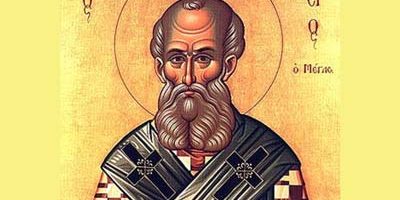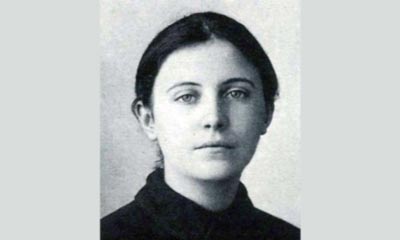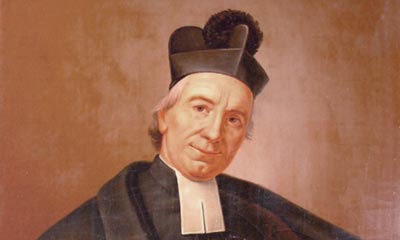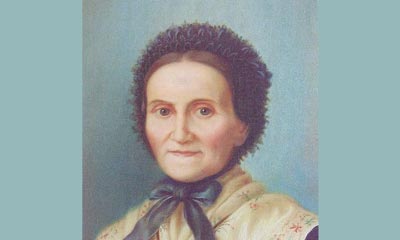April 21, 2021
Saint Athanasius
Dear Friends,
Several years before his death, St. Athanasius was already hailed as “the pillar of the Church” by St. Gregory of Nazianzus, the great theologian and bishop of Constantinople. In our time, both East and West still consider him as a model of faithfulness to the Catholic faith at a time when heresy (a doctrine that denies a tenet of the faith) seemed bound to triumph. He was Bishop of Alexandria, in Egypt, for forty-five years, during which period he endured exile for a total of more than twenty years.
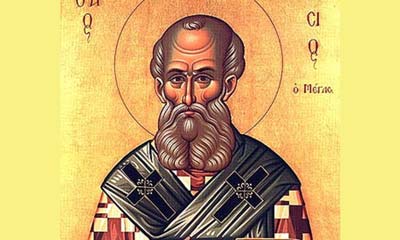 When Athanasius was born near Alexandria, around the year 298, the Empire’s official policy of Christian persecution had given way to de facto tolerance. In 313, Emperor Constantine issued the Edict of Milan that put an end to persecution. Athanasius was very well educated, particularly in Greek literature and philosophy. He joined the Christian clergy when he was still very young, remaining a lector for six years. His qualities attracted the attention of Bishop Alexander, who chose him as his secretary and trusted aide. It was at that time that a renowned priest of the diocese, Arius, cunningly began to spread a new doctrine denying Jesus Christ’s divinity, under the pretext of better adapting Christian doctrine to human reason. In 325, in his role of deacon and secretary to Patriarch Alexander, Athanasius actively participated in the first ecumenical council held in Nicaea, which formally condemned the heresy of Arius. Emperor Constantine officially approved the acts of the Council, giving them the force of a law of the State (though driven by good intentions, this approach ran the risk of compromising the Church’s independence with regard to the State). When Alexander died in 328, Athanasius was named his successor at just thirty years old, after the wishes of the deceased. The bishops of the province, the diocesan clergy as well as the people approved of this designation.
When Athanasius was born near Alexandria, around the year 298, the Empire’s official policy of Christian persecution had given way to de facto tolerance. In 313, Emperor Constantine issued the Edict of Milan that put an end to persecution. Athanasius was very well educated, particularly in Greek literature and philosophy. He joined the Christian clergy when he was still very young, remaining a lector for six years. His qualities attracted the attention of Bishop Alexander, who chose him as his secretary and trusted aide. It was at that time that a renowned priest of the diocese, Arius, cunningly began to spread a new doctrine denying Jesus Christ’s divinity, under the pretext of better adapting Christian doctrine to human reason. In 325, in his role of deacon and secretary to Patriarch Alexander, Athanasius actively participated in the first ecumenical council held in Nicaea, which formally condemned the heresy of Arius. Emperor Constantine officially approved the acts of the Council, giving them the force of a law of the State (though driven by good intentions, this approach ran the risk of compromising the Church’s independence with regard to the State). When Alexander died in 328, Athanasius was named his successor at just thirty years old, after the wishes of the deceased. The bishops of the province, the diocesan clergy as well as the people approved of this designation.
In Pope Benedict XVI’s words, Athanasius “was above all the impassioned theologian of the Incarnation of the Logos, the Word of God who ‘became flesh and dwelt among us’ (Jn 1:14).” He added: “With his theory, Arius threatened authentic faith in Christ, declaring that the Logos was not a true God but a created God, a creature ‘halfway’ between God and man… The Bishops gathered in Nicaea responded by developing and establishing the ‘Symbol of faith’ which, completed later at the First Council of Constantinople, has endured in the liturgy as the Niceno-Constantinopolitan Creed. In this fundamental text the Greek term homooúsios is featured, in Latin consubstantialis: it means that the Son, the Logos, is ‘of the same substance’ as the Father, he is God of God, he is his substance. Thus, the full divinity of the Son, which was denied by the Arians, was brought into the limelight” (General Audience, June 29, 2007). Saint Athanasius would devote his life to defending and explaining this Creed. His unremitting toil remains every bit as valuable today because Arianism continues to exist under new forms. The Modernists have sought to distinguish between the Christ of history, whom they consider merely to be a man, and the Christ of faith, who would be a God only in the eyes and subjectivity of believers. We also hear it said that Christ was not aware of his divinity. These opinions contradict the teaching of the Council of Nicaea. Jesus’ divinity is indeed an objective reality independently of the faith of believers. And if Christ is truly God, how could He be ignorant of the fact?
In the autumn of 329, Athanasius undertook a vast pastoral tour. At the monastery of Tabennisi, he ordained Father Pachomius to the priesthood. It was soon after this that the Semi-Arians, a group formed by those who were trying to circumvent the condemnations of the Council of Nicaea, began to oppose Athanasius. They drew up charges accusing him of tyrannical and even criminal management of the Church of Egypt. In 335, they seized the opportunity of an assembly of bishops in Tyre, which included many of their supporters, to ruin Athanasius’ reputation. As a result, on February 5, 336, Emperor Constantine exiled Athanasius to Trier. He remained there from the spring of 336 to June 337 (first exile). As Benedict XVI said, “During his forced absences from Alexandria, St. Athanasius was able to sustain and to spread in the West, first at Trier and then in Rome, the Nicene faith as well as the ideals of monasticism, embraced in Egypt by the great hermit, Anthony, with a choice of life to which Athanasius was always close. St. Anthony, with his spiritual strength, was the most important champion of St. Athanasius’ faith” (ibid.).
A solemn declaration
Emperor Constantine died on May 22, 337. His three sons (Constantine II, Constans I, and Constantius II) split up the empire among them. Constantine II, now the emperor over part of the West, restored Athanasius to his see in Alexandria. But Egypt fell under the authority of his brother Constantius II, emperor of the East, who supported the Arians. The Arians wanted the emperor to replace Athanasius on the See of Alexandria by one of their own. In early 339, with the approval of Constantius II, Gregory of Cappadocia, an Arian, was named Bishop of Alexandria. On April 16, Athanasius, pursued by armed troops, was able to board a ship bound for Rome. There, he was joined by several bishops who had been deposed by the Arians. Pope Julius I convened a council in Italy during the winter of 340-341; at the close of its deliberations, he solemnly acquitted Athanasius and the bishops exiled in Rome of the charges brought against them and declared them to be the rightful holders of their sees. He sent a letter to the Oriental bishops notifying them of his decision. But the Pope was formally rebuffed by a synod held in Antioch.
The pope then convened a General Council in Serdica (now Sofia, Bulgaria) during the summer of 343, with about one hundred Western bishops and ninety Oriental bishops. The latter immediately disputed the presence of Athanasius and the other exiled bishops, stating they had already judged them at the synod of Tyre. After lengthy disputes, the Oriental bishops left the city. The Western bishops, who remained in Serdica, proclaimed the innocence of the exiled Oriental bishops and deposed the usurping bishops. In the summer of 344, Athanasius went to Aquileia. He was welcomed by Constans I, who fully embraced the cause of the exiled bishops and succeeded in putting an end to the persecution of Athanasius’ supporters. However, Athanasius chose to remain in Aquileia until early 346. On October 21st of that year, he made a triumphant return to Alexandria. His second exile had lasted from April 339 to October 346.
Athanasius’ influence had by then become predominant in Egypt, thanks to the very considerable development of monasticism, driven by St. Pachomius (who died on May 9, 346). Most of the monks chose to support the bishop. He received a delegation from the monastery of Tabennisi, which welcomed him and presented him with a message from the very renowned hermit, St. Anthony (250-357). Athanasius promptly convened a synod to confirm the decrees of Serdica. Within two or three years, he was able to establish communion with more than four hundred bishops. He wrote doctrinal treatises and filled several vacant episcopal sees, often choosing the new incumbents from the ranks of the monks. He also wrote letters to the many consecrated virgins living in and around Alexandria, urging them to live according to the humbleness of their state. As a result of this pastoral activity, the Arians kept a lower profile.
Deposed once more
In February 350, Constans I was assassinated in Gaul. He was succeeded by Constantius II, who established his court in Arles. From this position of force, Constantius was able to renew his support for the Arians. In the autumn of 353, a Council of Gallic bishops was held in Arles in the presence of legates of Pope Liberius (Julius I had died in April 352). Under pressure from the emperor, the synod condemned Athanasius, but the pope refused to endorse this decision. A new council met in Milan in 355 at his behest, in the presence of the emperor. Threatened with exile, however, the majority of the bishops signed the decree deposing Athanasius. On January 6, 356, General Syrianus arrived in Egypt and ordered his troops to converge on Alexandria. On the evening of Thursday, February 8th, Athanasius was holding a service at the church of St. Theonas when the building was surrounded by soldiers; the doors were battered down and shortly after midnight, General Syrianus burst into the church in order to seize the bishop. Seated on his throne in the apse, the bishop remained calm and ordered the deacon to sing Psalm 135 with the faithful: “Give thanks to the Lord, for His mercy endures forever.” While the soldiers rallied at the chancel, the clergy begged Athanasius to flee. But he refused to move until the crowd of worshippers was safe. Prayers thus continued for a long while, until a group of monks and clergy suddenly surrounded the throne, seized the bishop and took him outside, in the midst of the greatest confusion. The Patriarch was led to the desert; he would not reappear in public until 362 (third exile).
Athanasius traveled to Cyrenaica, probably with the intention of heading West in order to parley with Constantius II. He has already begun work on his Apology to Constantius. At this point, he was informed of the severity of the repression that had been unleashed in Alexandria: on Easter Day, troops had attacked his followers. He also received a copy of a letter the Emperor sent to the Alexandrians, depicting him as a troublemaker and announcing the arrival of a new Arian bishop, George of Cappadocia. Realizing that attempting to negotiate would be futile, Athanasius wrote his Letter to the Bishops of Egypt and Libya, warning them against the Arian formularies and exhorting them to endure the persecution.
The Doctrine of Salvation
More than half of his writings date from these six years. As Pope Benedict said: “The most famous doctrinal work of the holy Alexandrian Bishop is his treatise On the Incarnation of the Word, the divine Logos who was made flesh, becoming like one of us for our salvation. In this work, Athanasius says, with an affirmation that has rightly become famous, that the Word of God ‘was made man so that we might be made God; and he manifested himself through a body so that we might receive the idea of the unseen Father; and he endured the insolence of men that we might inherit immortality’ (54, 3). With his Resurrection, in fact, the Lord banished death from us like ‘straw from the fire’ (8, 4). The fundamental idea of Athanasius’ entire theological battle was precisely that God is accessible… He is the true God and it is through our communion with Christ that we can truly be united to God. He has really become ‘God-with-us’” (ibid.). The expression “so that man might become God” does not mean that we would cease to be creatures. It designates man’s mysterious participation, in his created nature, in the blessed life of God as an adopted son.
Meanwhile, Sebastian, Egypt’s new chief of the military, was exerting every zeal in executing orders of systematic persecution. All the churches in Alexandria were assigned to the Arians. Twenty-six bishops of Egypt were removed from their sees. George of Cappadocia’s installation had been carefully prepared: it took place under military escort, on Friday, February 24, 357—one year after Athanasius’ flight. But the usurping bishop, with Sebastian as his armed force, quickly proved to be despicable, both through his tyranny and greed, persecuting both pagans and Christians who supported Athanasius. Meanwhile, Athanasius was constantly moving around Egypt, hiding in monastic cells in the Nitrian Desert or Upper Egypt, and even in old tombs or cisterns. More than once, he was even able to stay secretly in Alexandria, without ever being denounced or spotted by the police. During this exile, he completed his biography of the hermit St. Anthony of the Desert.
As Pope Benedict XVI recalled, St. Athanasius was indeed the author of The Life of Anthony, written “shortly after this Saint’s death precisely while the exiled Bishop of Alexandria was staying with monks in the Egyptian desert. Athanasius was such a close friend of the great hermit that he received one of the two sheepskins which Anthony left as his legacy, together with the mantle that the Bishop of Alexandria himself had given to him. The exemplary biography of this figure dear to Christian tradition soon became very popular, almost immediately translated into Latin, in two editions, and then into various Oriental languages; it made an important contribution to the spread of monasticism in the East and in the West… Moreover, Athanasius himself showed he was clearly aware of the influence that Anthony’s fine example could have on Christian people. Indeed, he wrote at the end of this work: ‘The fact that his fame has been blazoned everywhere, that all regard him with wonder, and that those who have never seen him long for him, is clear proof of his virtue and God’s love of his soul… For from whence into Spain and into Gaul, how into Rome and Africa, was the man heard of who dwelt hidden in a mountain, unless it was God who makes his own known everywhere?… For even if they work secretly, even if they wish to remain in obscurity, yet the Lord shows them as lamps to lighten all, that those who hear may thus know that the precepts of God are able to make men prosper and thus be zealous in the path of virtue’” (The Life of Anthony, 93, 5-6), (ibid.). Pope Benedict added: “We have many causes for which to be grateful to St Athanasius. His life, like that of Anthony and of countless other saints, shows us that ‘those who draw near to God do not withdraw from men, but rather become truly close to them’” (ibid.).
A call for reconciliation
Constantius II died on November 3, 361. He was succeeded by Emperor Julian who, although raised a Christian, had relapsed into paganism (which is why he went down in history as Julian the Apostate). On February 9, 362, he published an edict in Alexandria authorizing the return of all the bishops banished under his predecessor. This measure was surely intended to create new divisions within the Church. When Athanasius returned to Alexandria on February 21st, he realized that he must restore peace among the Christians. One of his first actions was to convene a synod that included twenty-one bishops who had been persecuted during the previous reign. An agreement was reached regarding questions of faith. But the situation remained complex: the hard-liners, who wanted to excommunicate anyone who had taken ambiguous positions, opposed the moderates who sought only to punish those primarily responsible for the heresy. The synod resulted in a Synodal Letter, the work of the bishop himself: it would establish him as the true leader of Oriental Christendom. The Nicene Creed was once again professed, together with a call for moderation and reconciliation.
Before long, Emperor Julian became annoyed by Athanasius’ influence; he wrote a public letter to the Alexandrians explaining that he had allowed the banished bishops to return to their city, but not to return to their positions. As a consequence, he ordered Athanasius to leave Alexandria. While his supporters tried to sway the emperor, Athanasius inconspicuously remained in his metropolis. But Julian threatened the Prefect of Egypt with sanctions if Athanasius, “this enemy of the gods,” did not leave the country. The bishop went into exile once more on October 23rd. He traveled up the Nile to Upper Egypt, where he was welcomed by bishops and monks. Athanasius was still there the following year when he learned of Julian’s death; his successor, Jovian, was a Christian. Athanasius secretly made his way to Alexandria, whence he left immediately for Syria with other Egyptian bishops in order to meet Jovian there. Although the Arians besieged the new emperor, demanding another bishop for Alexandria, Athanasius was reinstated. After a stay in Antioch, he re-entered Alexandria officially with imperial letters and took possession of all the churches. Thus ended his fourth exile (October 23, 362–February 14, 364).
Jovian died accidentally during the night of the 16th to the 17th of February, 364. Proclaimed emperor, Valentinian I appointed his brother Valens co-emperor for the East. Valens soon fell under Arian influence. In early 365, an imperial edict banned the bishops who had been deposed by Constantius II and recalled by Julian. Athanasius chose to remain at first, but a month later took refuge in a country house he owned. Severe political unrest compelled the emperor to restore him to his See in Alexandria. This marked the end of his fifth exile (October 5, 365–February 1, 366).
At the time, Athanasius was corresponding regularly with Basil of Caesarea. He spent his last years refuting Apollinaris of Laodicea, a heretic who identified the soul of Christ with his divinity (meaning that Christ was not really a man). But the Bishop of Alexandria’s writings took on a new tone: he showed himself less a bold defender of orthodoxy than a father saddened by his correspondent’s errors. He also spent time writing commentaries on the Scriptures. He wrote: “In addition to the study and true knowledge of the Scriptures are needed a good life and pure soul and virtue in Christ… so that the mind may be able to obtain and apprehend what it desires (the science of divine wisdom).” Saint Athanasius died on May 2, 373, in his seventy-fifth year.
Above all things
According to the Catechism of the Catholic Church, bishops “have as their first task to preach the Gospel of God to all men… They are authentic teachers of the apostolic faith endowed with the authority of Christ” (CCC 888). That is why St. Athanasius fought so hard, and suffered so much contradiction. He knew that “‘without faith it is impossible to please God’ (Heb 11:6)… and no one has ever attained justification, nor will anyone obtain eternal life, ‘but he who endures to the end’ (Mt 10:22; 24:13)” (CCC 161). Following in the footsteps of St. Paul, he fought the good fight of the faith (1 Tim 6:12). This fight is also ours: as Pope Francis said, “So often we today can find our faith challenged by the world, and in countless ways we are asked to compromise our faith, to water down the radical demands of the Gospel and to conform to the spirit of this age. Yet the martyrs (and all the saints) call out to us to put Christ first and to see all else in this world in relation to him and his eternal Kingdom” (August 16, 2014).
It was the Virgin Mary who believed in God’s loving plan for mankind. In Heaven, she is now endowed with the omnipotence of intercession over the Heart of God. Let us pray confidently to her and to St. Athanasius, that they may strengthen in us, amid our struggles, the virtue of faith united with firm hope in divine assistance!


